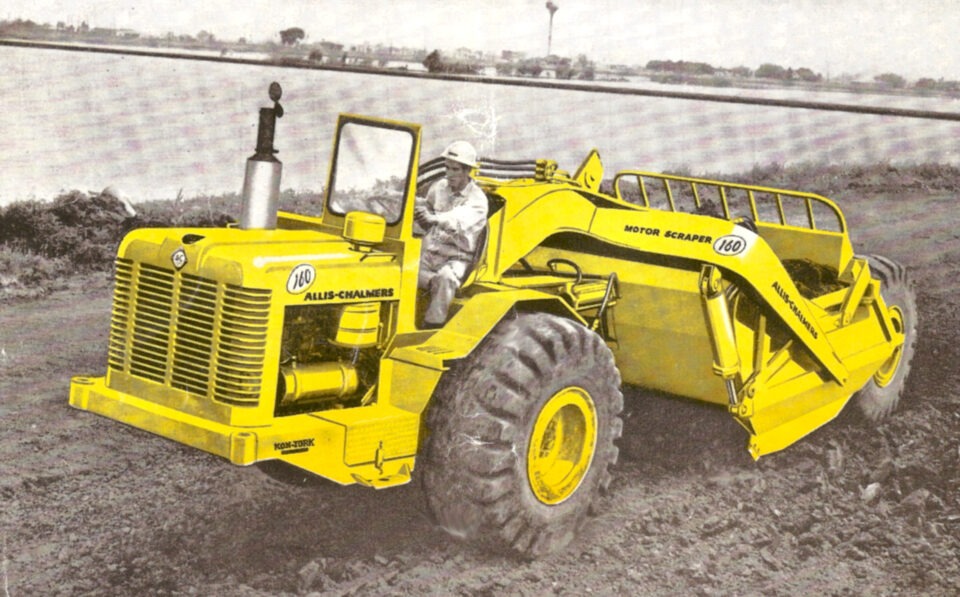Following World War Two, and well into the early 1950s, there was an explosion of earthmoving projects. Not all of these jobs required large equipment, and the machinery manufacturers of the day became quite inventive in bringing out new and improved machinery, almost on a monthly basis. By Richard Campbell.
The small, self-propelled, open bowl scraper market was very hotly contested with no less than five different manufacturers vying for machinery sales.
At the time, this market was dominated by Euclid (with its S-7) and LeTourneau-Westinghouse (with its Model D).
Allis-Chalmers was determined to get a piece of the action as well.
It should be noted that Caterpillar was an absentee from this size class, not offering a machine in this size category until 1969.
Allis-Chalmers had, in 1952, acquired the assets and manufacturing facilities of LaPlant-Choate, a pioneer of applying hydraulics to earthmoving machinery.
LaPlant-Choate already had two motor scrapers in production when Allis-Chalmers took it over, the TS-200 and TS-300, which were re-badged as Allis-Chalmers machines.
The TS-200 and TS-300 were redesigned not long after the takeover by Allis-Chalmers’ engineers and became the models TS-260 and TS-360.
However, both machines were designed for larger earthmoving projects and Allis-Chalmers required something a little smaller to compete in the seven to nine cubic yard category.
The designers, drawing heavily on their recent experience re-engineering the larger model TS-260, came up with the TS-160, which was released for sale early in 1957.
The new TS-160 was powered by an Allis-Chalmers model TDS-516 six-cylinder, supercharged, inline diesel engine rated at 155 flywheel horsepower.
Although marked “Allis-Chalmers”, the diesel engine was actually a Buda design, Allis-Chalmers having bought the Buda Engine Company outright in 1953, thereby not having to rely on other manufacturers to supply its engines.
Prior to its acquisition of Buda, Allis-Chalmers had been using General Motors and Cummins diesel engines in its machines.
Transmission, final drives, steering and brakes
Turning the horsepower into traction was a Fuller five-speed manual transmission connected to the engine by a 13-inch two plate dry clutch.
A clutch brake was standard for easier shifting.
Final drives were double reduction, spur gear type, very similar to those found in a track-type tractor of the period.
A conventional differential was fitted.
On standard 18×25 inch tyres, a loaded TS-160 was capable of just over 25 miles per hour in top gear.
A two-cylinder hydraulic steering system was used, which was identical to that fitted to the larger TS-260 and TS-360.
This allowed 90 degree turns to right or left and gave the TS-160 a respectable 25 foot turning circle, an important feature for a utility-size machine.
For stopping power, the TS-160 employed cam-operated, expanding shoe brakes on all four wheels. Actuation was by air.
Business end of the machine – the bowl
The TS-160’s scraper bowl was a scaled-down version of its larger stablemate, the TS-260, and was rated at seven cubic yards struck and 9.5 cubic yards heaped.
Operation was all-hydraulic except for the apron, which, although hydraulically activated, was actually raised by a 12-foot length of three-quarter inch cable and was sequenced with the ejector via a linkage system.
The bowl featured a three-section curved cutting edge, with all edges identical and reversible.
Due to somewhat lackluster sales of the TS-160, an attempt was made in 1961 to increase the machine’s attractiveness to potential buyers by raising the bowl’s capacity to 8.5 cubic yards struck and 11 cubic yards heaped.
This change was accomplished by adding small sideboards to the bowl sides and raising the ejector tailgate slightly.
The sideboards, by necessity, had to be small due to the way the apron linkage operated.
Operation of the TS-160
As was quite common during the 1950s, not a great deal of effort was put into designing an ergonomic operator’s area, and the operator’s position was rather spartan and contained few creature comforts.
However, a well-cushioned seat and a comprehensive set of gauges were provided along with a safety glass windshield.
Available as an optional extra was a full cab, non-ROPS (which did not exist at the time) with a heater for cold weather operation.
Another option was a rock dumper in place of the open bowl scraper.
However, it is believed that fewer than 10 of this variant were constructed.
In service
Unfortunately for Allis-Chalmers, the TS-160 did not perform as well as expected with only around 350 machines being sold during the machine’s time in production (1957-1961) making it somewhat of a rarity.
Unlike most of its competitors, the TS-160 was over width and somewhat overweight on its front axle, which required the use of a transporter to take it from job to job, largely defeating the utility nature of the machine.
The weight issue on the front axle also made it easy to bog the machine down in softer ground.
The Allis-Chalmers TS-160 was a contemporary of the Euclid S-7, Michigan 110, Curtiss-Wright CW-27, and LeTourneau-Westinghouse Model D.
New Zealand connection
At least two Allis-Chalmers TS-160s were imported into New Zealand by franchise distributors at the time the CablePrice Corporation.
These machines were delivered to Collins & Brown of Auckland (who also owned a Euclid S-7) and were initially put to work in the Helensville area of Auckland.
While their fate is unknown, at least one of the machines’ bowls was converted to a towed hydraulic scraper (parts for the tractor unit presumably being unobtainable).
For the model collector
Unfortunately for the collector, no model diecasts (or resin for that matter) of the Allis-Chalmers TS-160 exist in any scale.
If you really must have one, it will have to be a scratch building project.


Parting words from Jeremy Sole- a final column